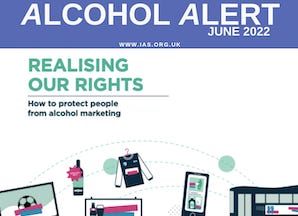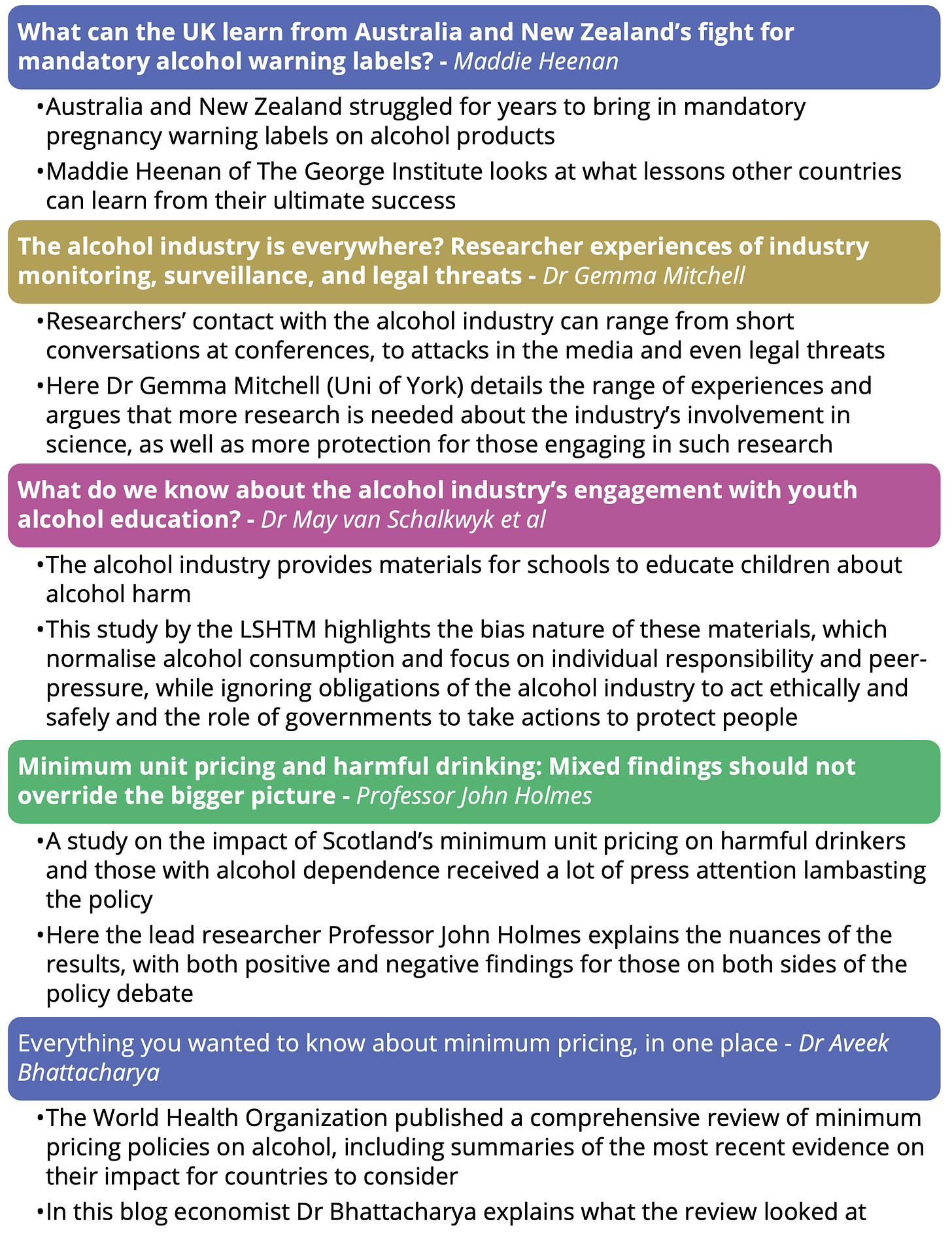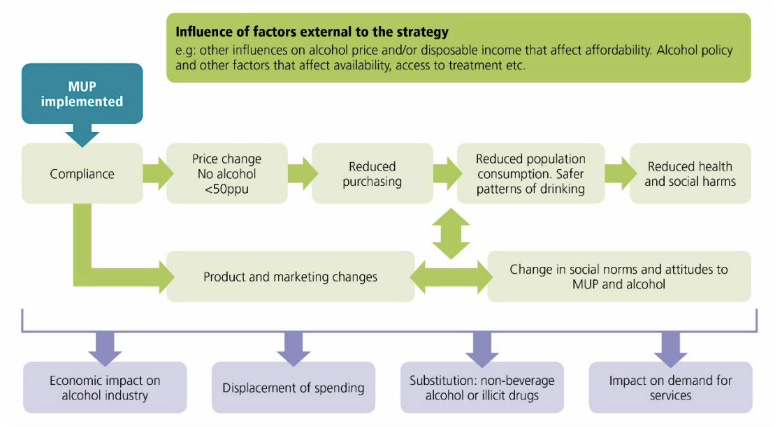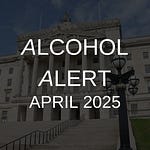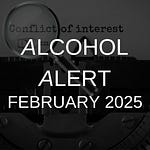Hello and welcome to the Alcohol Alert, brought to you by The Institute of Alcohol Studies.
In this edition:
International experts call for ban on all alcohol promotion 🎵 Podcast feature 🎵
‘No clear evidence’ MUP reduces harmful drinking
Vast difference in alcohol-related deaths remains between richest and poorest in Scotland
Contents Unknown: How alcohol labelling still fails consumers
‘No place for cheap alcohol: The potential value of minimum pricing for protecting lives’
Sobriety tags rolled-out further despite no evidence of efficacy
Irish Government makes moves to improve product labelling
Brexit Freedoms Bill could deliver pint-sized wine bottles
No and low alcohol sales double in the UK
Alcohol Toolkit Study: update
We hope you enjoy our roundup of stories below: please feel free to share. Thank you.
IAS Blogs
To read blogs click here.
International experts call for ban on all alcohol promotion 🎵 Podcast feature 🎵
Realising Our Rights, a new report launched on 28 June by Alcohol Focus Scotland (AFS) and a group of subject experts, calls on governments across the world to introduce comprehensive restrictions on alcohol marketing in order to improve health.
The publication explains how increasingly sophisticated marketing means that people are being constantly bombarded with positive messages about how alcohol enhances their lives. The alcohol marketing experts who helped develop the report point out that this seeks to build long-term relationships between people and alcohol brands, which reinforce alcohol as a social norm and ultimately contribute to high levels of consumption and harm across the world.
They particularly draw attention to at-risk population groups, with children and young people, and people at risk of an alcohol problem, more affected than others.
A number of additional pieces of research were commissioned to help develop the report, including research examining the impact of alcohol marketing on people with an alcohol problem. The complementary research found that this demographic has an increased susceptibility to alcohol marketing, which fosters positive alcohol-related emotions and increases their likelihood of drinking.
The group’s recommendations include:
Additional research for the report included analysing case studies from seven countries with marketing restrictions, to understand the processes, successes and challenges to introducing these restrictions. These case studies can be used by countries looking to introduce similar restrictions, to better understand issues around:
Utilising a window of opportunity
Opposition from the alcohol industry
How to frame regulations
Use of evidence and arguments
The AFS report includes a human rights-based approach to marketing restrictions, highlighting that states have a legal obligation to protect citizens’ rights – such as the right to health – and that commodities that infringe on these rights need further restriction.
AFS’ Chief Executive, Alison Douglas, said:
“The current self-regulatory approach to alcohol marketing is failing to protect people and has led to our communities being wallpapered with promotions for a product that harms our health.
“People don’t just have a need to be protected from alcohol marketing they have a right to be protected. A number of other countries have already imposed bans on alcohol marketing, if we want to create a more positive culture where everyone can realise their right to health, the UK and Scottish governments must act to restrict alcohol marketing.”
The Scottish Government is consulting this year on marketing restrictions, and the Minister for Public Health, Maree Todd said:
“I welcome this report and will study carefully its detailed findings and recommendations. I am determined to tackle the harmful impacts that alcohol marketing can have on children and young people, as well as the triggering effect it can have on heavy drinkers and those in recovery.”
Tom Bennett, one of the report experts who is in long-term, abstinent recovery from an alcohol problem, said:
“Alcohol marketing can be massively triggering; it’s designed to be. Seeing an image of a cold beer on a warm sunny day or a midwinter glass of whisky in front of an open fire can be highly appealing. Yet the message these images convey, that alcohol is life enhancing, is at odds with the health risks.”
‘No clear evidence’ MUP reduces harmful drinking
Public Health Scotland and the University of Sheffield released the final report on the impact of minimum unit pricing in Scotland, which suggests that among those drinking at harmful levels or those with alcohol dependence, there is “no clear evidence of a change in consumption or severity of dependence”.
It also found that some economically vulnerable groups saw increased financial strain as they ended up spending more on alcohol. Some of those surveyed reduced spending on other things such as food and utilities.
Public Health Scotland’s theory of change for MUP (reproduced from Beeston et al, 2019)
However, there was little evidence of other negative consequences, such as increased crime or a shift to illicit substances. As this was an argument frequently used against the introduction of MUP, it is an important consideration.
Further, the proportion of people who had drunk at hazardous levels in the last week fell significantly by 3.5% in the market research data. Other analyses of Scotland’s MUP have also found reductions in consumption among some population groups.
Professor John Holmes, the lead researcher on the project, highlighted in a recent IAS blog that MUP isn’t designed to reduce drinking for those who are dependent:
“Alcohol dependence is a more complex problem than harmful drinking and is best-tackled by early identification of alcohol problems and the provision of an accessible and effective treatment system.
“MUP may therefore only contribute to a reduction in alcohol dependence by preventing future cases rather than addressing current ones.
“Overall, our report offers a nuanced and mixed picture of the impact of MUP on a key population of concern, with both positive and negative findings for those on both sides of the policy debate.”
During a meeting of the health committee in Holyrood, Dr Sandesh Gulhane (Conservative MSP for Glasgow) claimed that MUP was failing, and that the most vulnerable were cutting back on food to afford the high prices. Professor Petra Meier responded that pricing policies alone would not be enough to alter the consumption for some very heavy drinkers, and investment in health services is also necessary: “addiction services have had major cutbacks during Covid, they have been virtually inaccessible unless you were able to join online groups and make do with things like alcoholics anonymous online and so on.”
Vast difference in alcohol-related deaths remains between richest and poorest in Scotland
In related news, Public Health Scotland (PHS) also released its MESAS report 2022 (Monitoring and Evaluating Scotland's Alcohol Strategy) on 21 June , which shows huge inequality between the poorest and most affluent adults who consume alcohol, in terms of hospital stays and deaths.
Rates of alcohol-specific deaths were five times higher in the poorest communities and hospital stays were nearly eight times higher.
Vicki Ponce Hardy of PHS said the report showed that significant inequalities were resulting in "preventable" deaths:
“The most recent survey data shows that almost a quarter (24%) of adults in Scotland still drink more than the recommended, low risk, weekly, drinking guideline. Among those exceeding the guideline, it's those in the lowest income group who are likely to consume the most."
Contents Unknown: How alcohol labelling still fails consumers
A new study by the Alcohol Health Alliance (AHA) looked at alcohol product labelling information on 369 products and found that:
The AHA recommends that the UK Government sets up an independent body to monitor and enforce mandatory labelling, based on the WHO’s best practice for labelling.
Professor Sir Ian Gilmore, AHA’s chair, said:
“Those who profit from the sale of alcohol cannot be trusted to willingly provide product information. Legislation on alcohol labelling must ensure that consumers have the full picture of the contents and risk to health of the products they buy through Government making clear labelling on all alcohol products a legal requirement.
“Given the choice, most alcohol producers are leaving this vital information off the labels, keeping consumers in the dark about what’s in the products they are drinking.”
Product discrepancies were also found
Matt Lambert, the chief executive of the industry body the Portman Group, responded:
“This report doesn’t correspond to the findings of Portman Group’s much larger and more comprehensive recent survey where we looked at 400 products including the biggest brands by market share – the ones which accurately represents what most customers are buying. That research found near universal coverage of industry best practice showing pregnancy warnings, alcohol unit information, signposts to responsibility messages, and four in five products carrying the Chief Medical Officer’s low risk guidelines.
“Industry self-regulation has been responsible for voluntarily delivering greater information and awareness for consumers and the AHA’s own report shows that significant progress has been made. The sector is firmly on track to provide more information to consumers without recourse to valuable Parliamentary time, public funding or mandatory measures.”
The UK Government is set to consult on alcohol product labels “in due course”.
‘No place for cheap alcohol: The potential value of minimum pricing for protecting lives’
The World Health Organization has published a comprehensive review of minimum pricing policies, in order for states and policymakers to understand the best available evidence and implementation practicalities on these policies.
The report looks at evidence from simulation modelling studies and real-world studies in Scotland and Canada, which show encouraging results regarding reducing overall alcohol consumption.
It goes on to look at objections and concerns around minimum pricing policies, such as any adverse economic impact and increases in illicit alcohol, and finds little to support these.
As Scotland struggled to introduce minimum unit pricing due to legal battles with the whiskey industry, the report discusses requirements for the policies to be consistent with international trade law.
International comparisons of minimum pricing rate
As Dr Aveek Bhattacharya, one of the report’s lead authors, explained in an IAS blog this week:
“Here in one place, WHO Europe has collected a fact base on how and how well the measure works in different countries.
“It is, to our knowledge, a unique resource, and we hope it will be useful to policymakers as other governments consider taking the leap in future.”
Sobriety tags rolled-out further despite no evidence of efficacy
From the 15 June, the Government rolled-out so-called ‘sobriety tags’ further. The tags monitor alcohol through sweat and are being used for prison leavers if their probation officer thinks they could reoffend when drinking.
Alcohol is believed to play a part in 39% of violent crime in the UK and roughly 20% of offenders supervised by the Probation Service are identified as having drinking issues.
Justice Secretary Dominic Raab said:
“We’ve seen that alcohol tags work - with tagged offenders complying 97% of the time. That’s why we’re going to double the number wearing them from 900 to 1,900 over the next two years, focusing on those leaving prison on license.”
This focus on compliance while wearing the device says little about whether the scheme works in the long-term in reducing reoffending. As Dr Carly Lightowlers wrote in an IAS blog last year:
“A focus on compliance – in terms of alcohol-free days – is somewhat of a smokescreen as what is needed is evidence of whether drinking and related offending are reduced in the long term after tag removal, which is yet to be provided.”
Additionally, a report from the National Audit Office released on 8 June said a failed plan to transform the electronic tagging system has wasted £98 million.
The report says that the Government does not know if tagging offenders is helping to cut reoffending because of failings in the system, and that efforts to change the system were abandoned in March after 11 years and £153 million.
Irish Government makes moves to improve product labelling
Last week, the Irish Examiner reported that the Irish Government has made an application to the European Commission to enact regulations that would require health warnings on all alcohol products. These would include warnings regarding liver disease, fatal cancers, and consuming alcohol while pregnant.
The regulations also provide for those selling alcohol in licensed premises to be required to display a notice containing the same health warnings, a link to the public health website and an indication that the alcohol and calorie content of products is available on request.
The measures are contained in the Public Health Alcohol Bill, which has introduced a range of interventions including minimum unit pricing and restrictions on advertising at sporting events.
Brexit Freedoms Bill could deliver pint-sized wine bottles
In a Telegraph article on the first day of June, Brexit Opportunities Minister, Jacob Rees-Mogg, was said to be “spearheading the drive to ditch unnecessary regulations” around the sale of alcohol.
One of the mentioned regulations was that sparkling wine “can only be sold in traditional champagne-style glass bottles, complete with mushroom cork and foil”. The article states that regulations about bottle sizes could be scrapped, meaning wine producers could offer pint-sized bottles for the first time in half a century.
Another rule that says drinks cannot be called wine if they are under 8% could be got rid of, meaning no and low-alcohol wines can be referred to as wine, instead of synonyms such as “wine-based drink”.
The article states that:
“The plans, set to be outlined in the upcoming Brexit Freedoms Bill, could be enacted swiftly because legislation giving ministers the power to make the changes has already passed Parliament.”
Patrice Noyelle, President of Pol Roger Champagne, presents a pint bottle of champagne to the Churchill Museum and Cabinet War Rooms in 2008. CREDIT: Daniel Jones
No and low alcohol sales double in the UK
According to alcohol market research group IWSR, sales of no and low alcohol products in the UK have doubled from 2016 to 2021, from $240m to $454m. Alcohol-free sales tripled from $52m to $184m.
Emily Neill, head of research at IWSR, said promoting low-alcohol drinks was partly a commercial decision by companies:
“What you’ve seen in markets such as the UK and US is consumers becoming much more conscious of their health…there’s a higher proportion of younger consumers who don’t drink at all or would like to moderate their consumption.”
AB InBev said six years ago that it would aim for low-alcohol and no-alcohol beers to make up a fifth of sales by 2025, a target it admits it is unlikely to meet, with about 6% of sales currently from the products.
Despite this, sales of no and low alcohol products are still very low in the UK. A study summarised in an IAS blog last year showed that of UK households that bought alcohol, only “0.92% also bought zero alcohol beer between 2015 and 2020” and only “2.17% bought low alcohol beer”.
Alcohol Toolkit Study: update
The monthly data collected is from English households and began in March 2014. Each month involves a new representative sample of approximately 1,700 adults aged 16 and over.
See more data on the project website here.
Prevalence of increasing and higher risk drinking (AUDIT)
Increasing and higher risk drinking defined as those scoring >7 AUDIT. A-C1: Professional to clerical occupation C2-E: Manual occupation
Currently trying to restrict consumption
A-C1: Professional to clerical occupation C2-E: Manual occupation; Question: Are you currently trying to restrict your alcohol consumption e.g. by drinking less, choosing lower strength alcohol or using smaller glasses? Are you currently trying to restrict your alcohol consumption e.g. by drinking less, choosing lower strength alcohol or using smaller glasses?
All past-year attempts to cut down or stop
Question: How many attempts to restrict your alcohol consumption have you made in the last 12 months (e.g. by drinking less, choosing lower strength alcohol or using smaller glasses)? Please include all attempts you have made in the last 12 months, whether or not they were successful, AND any attempt that you are currently making.
The UK Alcohol Alert (incorporating Alliance News) is designed and produced by The Institute of Alcohol Studies. Please click the image below to visit our website and find out more about us and what we do, or the ‘Contact us’ button. Thank you.

